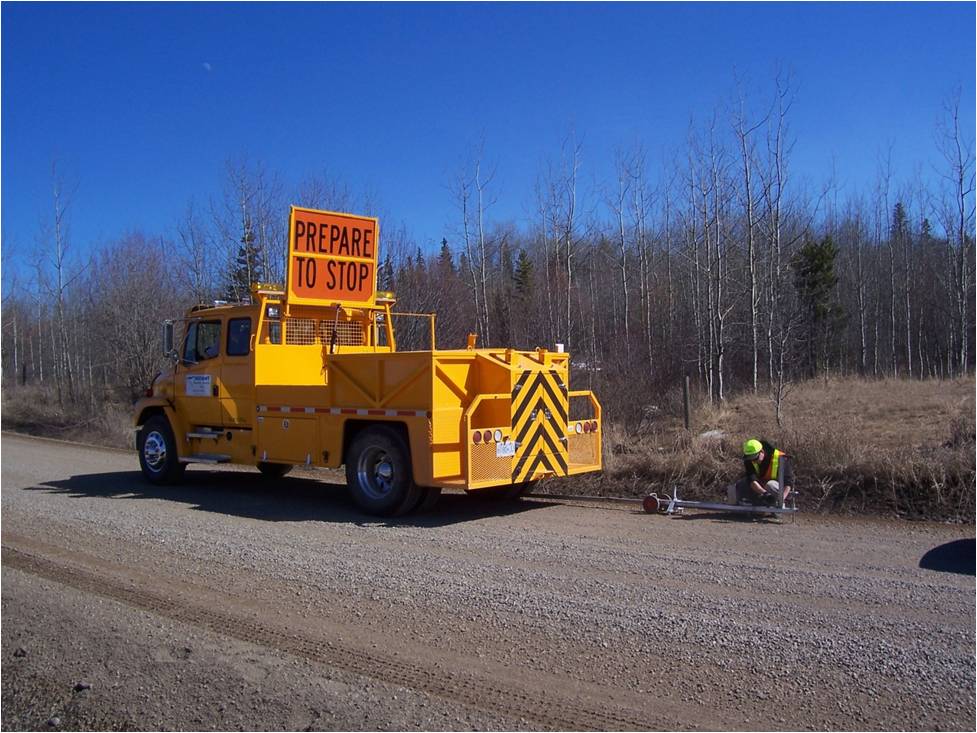There seems to be an official week or day for everything these days – yar, there’s even Talk Like a Pirate Day. Seriously… it was just last month. But there’s credibility behind something like National Science and Technology Week that silly accents simply can’t match.
New technologies have allowed the Ministry of Transportation and Infrastructure to improve safety and efficiency for travellers. To help you visualize some of the ways we’re utilizing technology, we collected some photos of our gizmos and gadgets.
New asphalt makes a smoother ride – but just how much smoother? Well, there’s an app for that. No, not that kind of app, but rather a machine called a high-speed inertial profiler, which uses an accelerometer, a range measuring laser and a distance meter to collect data and calculate the road’s smoothness. Inertial profilers allow us to gauge if and when road repairs or maintenance are required. The tool also determines if the smoothness of a recently paved road meets ministry standards before final payment is made to our paving contractor.
In an effort to prevent collisions with deer in highly populated areas on Highway 97, solar powered LED deer crossing signs light up based on the time of day and year.
- Mid February to the end of April – the lights flash from dusk to dawn – when deer tend to cross the highway seeking water or new ground.
- May – the lights go out and stay off for the sunnier (and quieter deer) months.
- Late September to mid February – the lights flash 24 hours a day. This is mating season, when the animals are less wary, and deer sightings and collisions are most common.
DriveBC’s growing network of BC HighwayCams is definitely one of the most popular features in the ministry’s “techie” arsenal. Travellers can get an online glimpse of traffic and weather conditions at more than 250 highway locations even before getting behind the wheel.
 Laying asphalt requires more precision than you may think. The asphalt needs to cool before quality control testing can be done. Crews use a laser thermometer to check the temperature of the compacted asphalt before performing a nuclear densometre test on the base layer to ensure that there has been enough compaction before the final layer of asphalt can be applied.
Laying asphalt requires more precision than you may think. The asphalt needs to cool before quality control testing can be done. Crews use a laser thermometer to check the temperature of the compacted asphalt before performing a nuclear densometre test on the base layer to ensure that there has been enough compaction before the final layer of asphalt can be applied.
 The tight curves on Highway 3 near Skagit Bluffs feature two technological tidbits to warn drivers to slow down. Illuminated LED chevrons automatically adjust intensity based on brightness of day, so drivers can see them easily, whether it’s during the day, night or even in bad weather. Also, a vehicle calming “slow down” sign (outside the frame of this photo, but shown in this video) is controlled by a speed sensor and located well before the curve. The sign lights up when drivers exceed the posted speed limit by 10 km/h or more, giving extra warning of the curve ahead.
The tight curves on Highway 3 near Skagit Bluffs feature two technological tidbits to warn drivers to slow down. Illuminated LED chevrons automatically adjust intensity based on brightness of day, so drivers can see them easily, whether it’s during the day, night or even in bad weather. Also, a vehicle calming “slow down” sign (outside the frame of this photo, but shown in this video) is controlled by a speed sensor and located well before the curve. The sign lights up when drivers exceed the posted speed limit by 10 km/h or more, giving extra warning of the curve ahead.
 Seasonal load restrictions for commercial vehicles are enforced in the spring, when temperatures rise, ice thaws and roads weaken. The ministry monitors road strength by using a handy piece of equipment called the Benkelman Beam. “Beaming” is done by placing a load on the road and measuring the rebound. This shows when the road has dried enough to regain its strength, allowing commercial drivers to resume carrying full loads without damaging the road.
Seasonal load restrictions for commercial vehicles are enforced in the spring, when temperatures rise, ice thaws and roads weaken. The ministry monitors road strength by using a handy piece of equipment called the Benkelman Beam. “Beaming” is done by placing a load on the road and measuring the rebound. This shows when the road has dried enough to regain its strength, allowing commercial drivers to resume carrying full loads without damaging the road.
From highly durable resin lane markings, to warning signs that sense the presence of cyclists, there is science and technology behind much of what we do. How are emerging technologies affecting your travel experiences?



Join the discussion